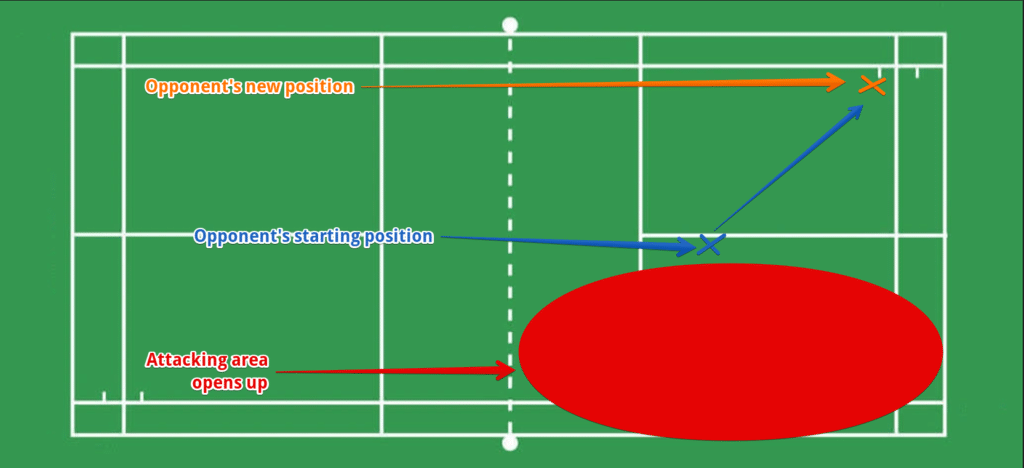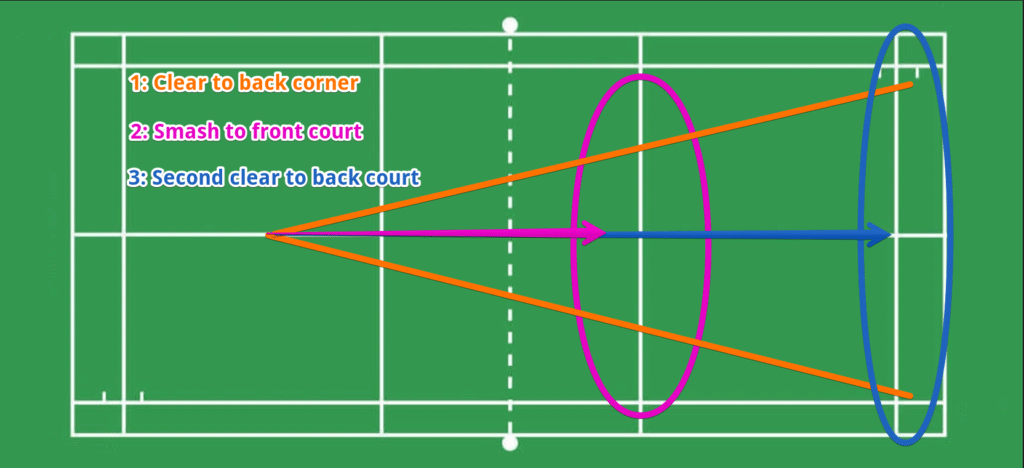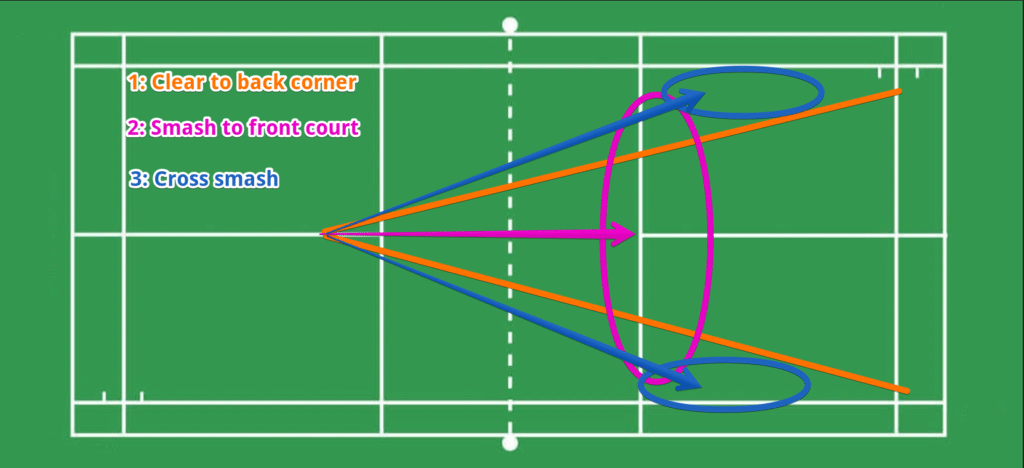A presumably boring and defensive maneuver, considered to be the simplest technique in badminton.
Anyone with a badminton racket in their hand for the first time can learn how to perform this strike in less than one hour. People do this in their backyards, with a racket in one hand and a can of beer in the other. It’s so easy a child could do it – and they do.
As soon as you’ve shown that you can clear shuttles with reasonable technique to the rear court – the badminton clear shot is mostly an afterthought.
It becomes background noise compared to other much more exciting techniques.
It’s weird because we still use it constantly in rallies, but often it’s more of a reactive decision you make when you feel out of balance or position or see your opponent standing all the way up on the front court.
If anything goes wrong, you can always clear it, right?!
How often do you rave to your friends about this sick clear you hit the other day?
No one ever does that.
At best, it’s considered a reset button for a rally, and most badminton players watching a match will think – “Ahh, he/she cleared… now they’ll build up the rally from the beginning again.”
Or you’d assume that a player was in trouble, and by hitting a clear shot, they bought themselves a little extra time to regain their position.
But what if the reason you don’t rave about your clear shots is that there’s a huge untapped potential? Something in this boring routine shot that presents exciting new options once you peel off a few layers?
After this, you won’t think a clear is just a clear.
The clear shot in badminton is an iceberg with deeper secrets
Probably the very first technique anyone who picks up a badminton racket learns is the badminton clear shot.
Executed well enough, they shouldn’t be able to jump up and attack the shuttlecock, and you’ll ideally have gained a few extra seconds to get back in position after you just saved a shuttle that put you out of balance.
The most common version of this is the forehand clear which is also an overhead clear in badminton.
With more advanced skills, you can also do a backhand clear.
Many players learn how to clear with the conviction that it’s the most basic and easy shot in badminton. It’s something to keep in your back pocket as a tool to save yourself or take the pressure out of rallies from time to time.
Talk about the tip of the iceberg. Is that really all there is to it!?
I used to think so, but after taking a closer look, I found out that this dark horse of badminton strikes is actually way more powerful than you’d think, and it can take a lot of players by surprise when used deliberately and tactically in rallies.

Let’s dive below the most regular options.
The uncommon and underrated way to approach the overhead clear in badminton
You can assume that whenever we’re talking about a clear shot, we’re talking about; an overhead forehand stroke in badminton or some version of it.
It’s by far the most common way to clear, but in the badminton community, people also distinguish between offensive and defensive clears.
The defensive clear is the one you know. It sends the shuttle in a high slow arch towards the back of the court and is typically used to buy more time to collect yourself.
The offensive clear, however, is faster and can be used to catch your opponent off guard and put the shuttle behind them. Because it isn’t as high and slow as the defensive version, they’ll typically have to rush back to return it.
This video illustrates both versions.
As a fundamental base for clears in badminton:
- An overhead clear shot that you strike in your forehand
- An offensive and a defensive version
- A backhand clear (sometimes)
Within this base understanding of the badminton clear shot, there’s a lot more wriggle room than you might’ve first imagined.
You can use this shot in a much more proactive and strategic way by incorporating it as a part of setting up combos and even tricking your opponent (more on this later).
Because many badminton players take this shot for granted and don’t give it much consideration – (I used to consider this the lowest level shot in the sport) – there’s ample opportunity to exploit what most players only think of as a last resort.
You might think that when someone clears, it’s a sign that they’re under pressure. That they almost folded and somehow lived to fight another shuttle.
However, if you study professional players using clears, they often seem to have the exact opposite approach to it.
It’s a complete myth that badminton clear shots should be considered a last resort or even a basic shot, for that matter.
Just look at how often it’s used in drop-in sessions or top-level matches like this one:
Professional players aren’t afraid to clear (and clear often) in their rallies even when they’re under no pressure whatsoever. They don’t seem to approach it as a last resort.
What’s more interesting is that at a high level, the defensive clear is an effortless way to defend against a flurry of attacking shuttles without exerting too much energy, while your opponent smashes and drives themselves to fatigue.
Of course, sometimes it’s simply to change the pace, but more often there’s a deliberate tactical aspect.
It’s constantly used both defensively and offensively, and you’ll also notice that it’s also used as a base to set up following strikes.
This is where the power of clear shot badminton players starts to unfold.
In professional badminton, I would say it’s even treated like a sneaky technique that can end rallies before anyone know what hit them – and leave opponents confused about why they keep ending up under pressure.
It’s like “The Five Point Palm Exploding Heart Technique” in Kill Bill.
Once you’ve set your combo up with a well-timed tactical clear, you can trace the rest of the rally step-by-step to the kill shot you plan to deliver – your opponent doesn’t even see it coming until it’s too late.
Done the right way, you can keep gaining advantage two-three strikes ahead. All because of a measly clear.
Sneaky ways to exploit clears
To gain an advantage with your clear shot, you’ll want to use it at the start of your attacking combos.
It starts with a clear (obviously), but while your opponent thinks you’re trying to win more time or change the pace, you’ll be directing their position on the court for what comes next.
Imagine the following scenario as an example:
You clear to the left corner of the rear court, so your opponent is positioned in a way that opens up the right and front court.

(You can use an offensive clear to rush them back or a defensive clear where they’ll have more time to decide – either version can work).
Assuming that you executed this correctly, it’s fair to expect your opponent will defend the shuttle by sending back either a drop shot or a clear themselves.
That means, if you’ve positioned yourself mid-court, you’re ready to skip back and attack the shuttle with a smash if they send a clear back at you or return a drop with a close net shot.
(Both of these opportunities can be played to the front court to force them to rush forward to defend again).
The main advantage here is that you’re mentally ready for two different outcomes and can decide your next strike with a much more rapid reaction which keeps tremendous pressure on your opponent – even if they’re able to defend your next move.
You can also more easily plan a variety of combos.
If you know you want to attack the shuttle with a smash, your opponent will almost certainly be forced into a quick defensive reaction (depending on how good their positioning is).
This opens up attacking opportunities, from smashing back again to driving or cross-lifting the shuttle – you’ll be playing proactive, they’ll be reactive.
Taking your clears even one step further, you can follow up on strikes with an unexpected clear to make your opponent run back and forth on the court. That can be done by disguising your clear, (I’ll talk about this technique in a moment).
Tip: (if you want to make it even more sneaky, you’ll clear to the corner of your opponent’s backhand, which generally has less power and puts them in a more awkward position.)
This is where you might want to spend a little more time practicing your clears as you start to see the advantage it can provide.
The “Three Strike Exploding Clear Combo Technique”
Combo#1
Strike 1 – Offensive/defensive clear to one of the back corners
Strike 2 – Drop shot to the front court at the side furthest away from the opponent
Strike 3 – Cross lift to either side of the court

Combo#2
Strike 1 – Offensive/defensive clear to one of the back corners
Strike 2 – Smash to front court
Strike 3 – Clear to backcourt again

Combo#3
Strike 1 – Offensive/defensive clear to one of the back corners
Strike 2 – Smash to front court
Strike 3 – Cross smash anywhere on the court

These are just a few ideas, and you can create several combinations and develop your own, but it’s probably a good idea not to think more than two or three strikes ahead since it starts getting complicated after that.
Of course, there’s always a possibility that your opponent reacts better than expected, and you might have to abort your combo or end up defending because they somehow managed to attack your clear or the following combination strikes.
These things happen in the heat of battle, but the advantage of using this “lame” shot is that it’s very easy to start over and set up new combos again.
If you’re patient enough, you can keep striking clears throughout your rally where you feel confident and comfortable.
Now, keeping this in mind, I want to talk about disguising your clear shot.
This technique is great in rallies where you seemingly have an opportunity to drop or smash (which will be the more obvious choice).
Because of that expectation, you can catch your opponent completely off guard with a disguised clear instead, especially when they’re at the front court.
Deceptive shots are well-known and there are two reasons the technique is great for clears too.
1. It’s straightforward because you set it up with a basic overhead clear badminton technique. 2. Because an overhead clear can be super hard to distinguish from a smash or drop, that makes it sneaky.
Depending on whether you’re playing with an intermediate racket or a beginner racket you’ll adjust your technique to be faster or slower to disguise the shot without taking away power and control.
You want to make it look like you’re about to send a drop shot or a powerful smash – and you want to send that signal clearly.
Then at the final moment, you send an overhead clear instead, completely unexpected.
However, you must wait until the last moment possible to really catch them off guard.
You’ll see your opponents fall over their own feet when they’re expecting to defend a smash and instead have to rush to the rear court.

It’s not a trick shot like this, but it will almost feel like it.
Now that you can start playing around with clears to set up different attack combos, what about when your opponent clears to you?
Diminish your opponent’s shot effect
Another way to level up your game is if you become good at predicting the specific movements other players make when they’re about to send a clear so you can attack it with a better advantage and more power.
(Use this with caution as they could be setting up for a smash instead).
There are specific indicators of stance, foot movement, and racket placement that reveal the likelihood of a clear shot.
The most obvious indicator is to watch their racket.
Players will typically drag their racket slowly with the head of the racket lifted high in the air, then snap it back and come up to swing at the shuttle. Watch the non-racket arm being lifted slowly higher and higher and watch as their elbow come up with the racket facing down in front of them.
The second thing to watch out for is their stance and foot movement.
Much like when you set up for a clear yourself, they’ll most likely start in a neutral stance with slightly bent knees. Their first movement will be one step backward, followed by a skipping jump backward like a scissor kick.
This skipping jump is the big giveaway, and when you see this combined with the racket indicator you can start moving backward on the court and get ready to attack what will most likely be a clear of some version.
The final ingredient to becoming a chess master of the badminton clear shot
After clearing, what is your next move?
This comes back to some of the combos you saw earlier, but positioning and thinking ahead is one of the biggest advantages you can give yourself to execute a combo you’re controlling with higher success, and to be ready for unexpected strikes from your opponent.
With better positioning, you not only give yourself more time to focus on hitting strikes with good technique, and set up combos, but you’ll also learn how to read other players’ movements better.
Notice the main thing about positioning is deciding where you’re going next immediately after you’ve hit the shuttle.
One of the biggest mistakes you can make is to remain idle which forces you to constantly react and makes it nearly impossible to plan strike combos ahead.
Takeaways: your future game after unleashing the dark horse of the clear shot
Hopefully, your mind is spinning with ideas on how you can use clears for much more advanced tactics than what’s in your repertoire now.
By going a little deeper than the standard uses of clear shots you can:
- Use it as a smooth setup for your combos
- Use it to re-start new combos
- Use it to re-position your opponent
- Use it to gain and regain advantage two-three strikes ahead
- Use it to play sneaky clears in unexpected situations
- Use your knowledge to anticipate your opponent’s clears and attack more effectively
By experimenting more and more with this technique, there’s a good chance your game also starts to feel way more fluid, and who knows, maybe it’ll become a secret weapon that you can keep using to put the pressure on in rallies with your badminton friends who’ll start to look at clears in a different light.
